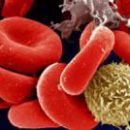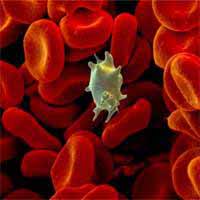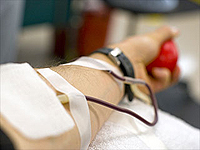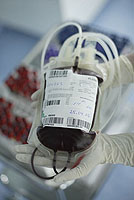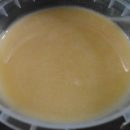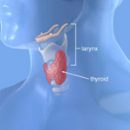One of the most effective methods of cleansing the body, from the position of the ratio of efficiency, quality and safety, is Plasmapheresis. This is the procedure for removing blood plasma from the body with toxic substances dissolved in it.
Content
The essence of the method
One of the most effective methods of cleansing the body, from the position of the ratio of efficiency, quality and safety, is Plasmapheresis. This is the procedure for removing blood plasma from the body with toxic substances dissolved in it. The mechanism of action of plasmapheresis consists in rapid removal of circulating blood and, accordingly, a decrease in the concentration of factors causing the disease.
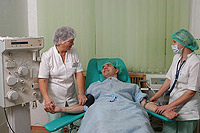 Plasmapheresis is performed in a special office, the patient sesides or lies, during the procedure it can read, watch TV, keep telephone conversations, talk with medical personnel or just sleep. A needle is installed in the elbow vein, the blood is taken and its filtering with a plasma removal, after removal of the plasma, a condensed blood cell mass («Erytomassa») Patient returns.
Plasmapheresis is performed in a special office, the patient sesides or lies, during the procedure it can read, watch TV, keep telephone conversations, talk with medical personnel or just sleep. A needle is installed in the elbow vein, the blood is taken and its filtering with a plasma removal, after removal of the plasma, a condensed blood cell mass («Erytomassa») Patient returns.
The procedure is performed by one-time tool, which completely eliminates the possibility of infectious disease infection.
The duration of such procedures varies from 1.5 to 3 hours, after which the patient leaves the wall of the clinic and can be engaged in anyone familiar to themselves (work, driving motor vehicles, play sports, etc.).
Removing the disintegration of drugs, toxins, other pathological products, non-surprises, plasmapheresis procedure reduces the toxic effect on the liver, kidney and other organs and create a reserve of strength in detoxification bodies for a long time. As a result, the body's resistance to external influences increases, decreases in the hospital stay.
The effect of application of plasmapheresis is:
- Reducing the concentration of pathological substances in the blood and tissues,
- General stimulating action on metabolism,
- Normalization of immune status,
- improving microcirculation,
- strengthening oxygen metabolism in tissues.
This leads to an increase in the sensitivity of the patient for pharmacotherapy and reducing the risk of complications, a significant improvement in the health of patients.
The need for Plasmapheresis is proved in the complex treatment of such concomitant diseases, as viral hepatitis B, C, D, hepatosis, cirrhosis.
Each method of plasmapheresis is focused on a certain clinical situation and is determined by the doctor.
For a full-fledged internal sanitation, 4-6 plasmapheresis sessions are usually required, for which a total of 1-3 circulating plasma volumes are removed (ODC). Calculate the PCL can be individually based on the fact that 1kg. Body masses in men account for 43 ml. plasma, and in women – 41 milliliter. Intervals between procedures are 2-3 days.
Indications for Plasmapheresis
Indications for the use of plasmapheresis can be:
- Bronchial asthma, pneumonia, chronic bronchitis, pleurisy, alveolitis;
- Chronic gastritis, chronic pancreatitis, chronic cholecystitis, nonspecific ulcerative colitis, diffuse liver diseases, hepato-cerebral encephalopathy;
- Hypercholesterolemia; Ischemic heart disease, post-infarction syndrome, hypertensive disease, virus myocarditis, autoimmune cardiomyopathy;
- Chronic purulent otitis, sinusitis;
- Pyelonephritis;
- Neurodermatitis, psoriasis, furunculosis, atopic dermatitis, herpes, toxicodermia;
- Drug and food allergies, polynomy;
- Poisoning of various genes, alcoholic disease;
- Urogenital infection: chlamydia, mycoplasmosis, cytomegalovirus;
- Diabetes mellitus, thyrotoxicosis;
- Rheumatoid arthritis, polyarthritis;
- Dermatomiositis, system red lupus;
- Bacterial and viral infections;
- Discciculatory encephalopathy, allergic encephalitis, multiple sclerosis, Reiter disease;
- Early and late toxicosis of pregnant women, inflammatory diseases in gynecology, sclerocystic ovarian syndrome;
- Condition after burns, severe injuries, diseases;
Contraindications for Plasmapheresis
Contraindications to Plasmapheresis are:
- The presence of a source of surgical bleeding;
- The presence of potential sources of bleeding (ulcers, erosion, tumors of the gastrointestinal tract, lungs);
- Acute stage of infectious and purulent-inflammatory processes (abscess, phlebitis);
- Extreme degree of blood circulation;
- Pronounced hypoproteinemia;
- Blood coagulation disorders;
- Hypotension below 90/60 mm.RT.Art.;
- Myopia (myopia) is high;
- Menstruation period in women (critical days).

